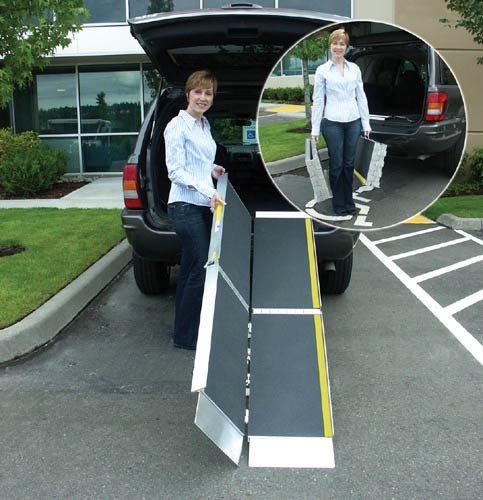Steps are frequently used to gain entrance to our homes, but for others, this access may be restricted. When stairs provide a challenge, wheelchair ramps provide a solution for maintaining physical health and independence.
And if you or a loved one requires a wheelchair, installing a metal wheelchair ramp in your house is unquestionably useful. But which ramp is right for you? Continue reading to learn about the many types of home and portable wheelchair ramps.
-
Threshold Ramps
A threshold ramp can be made of metal or rubber. They’re made to fit flat against the lip of a curb or the threshold of a door. Threshold ramps typically range in height from one to six inches. They’re also incredibly light, and they can be used on both the inside and outside of a doorway.
Threshold ramps are simple to install, inexpensive, and provide excellent mobility options for those who use wheelchairs, scooters, or walkers.
-
Portable wheelchair ramps that are longer
-
Baggage ramps
This sort of ramp is small and lightweight, and it folds up for easy transport, use, and storage. They can carry up to 450kg of weight depending on the provider. This makes them perfect for larger powered wheelchairs. They can come in lengths of up to 2400mm or 8ft, making them appropriate for step heights of up to 200mm or 8 inches.
-
Trifold Ramps
Trifold ramps are identical to the ones described above, except they fold into three for ease of transportation and storage. Most models involve the insertion and removal of a pin, thus the person assembling them must have strong eyesight and hand dexterity. The main advantage is that they are available in lengths of up to 10ft (3050mm), making them perfect for a larger number of stairs or deeper treads.
-
Rolling ramps
Roll-up wheelchair ramps are excellent in circumstances when the ground is uneven. It is powerful but pliable structure adapts to the terrain. They may be shortened or lengthened to meet your needs, making them ideal for usage when the height of the step change is unknown.
-
Ramps that are modular
If you are staying at a place for an extended amount of time, you can get a larger portable wheelchair ramp. They provide access when there are a substantial number of stairs to a door. They can also be created with a platform at the top and bottom for ease of access. During the specification phase, you can also request handrails at the height you desire, as well as include a flight of stairs for other members of the family or the general public.
-
Ramps that are permanent
This is yet another excellent option for residential wheelchair ramps. They are usually composed of concrete or wood. This ramp cannot be adjusted or moved once it has been installed. As a result, you’ll need building permission to create it. Unlike a modular ramp, this type of fixture is entirely constructed on-site. This means that construction and installation will be more time-consuming than with a modular ramp. When the homeowner also wants the ramp to match the appearance of the home. These ramps are frequently erected instead of modular ramps.
Advantages of Using a Wheelchair Ramp
“A wheelchair ramp is ideal for folks who want to move around the house independently.” Wheelchair ramps are both convenient and long-lasting. They also reduce the need for a caregiver to transfer a people while giving the person in the wheelchair more flexibility.
Furthermore, wheelchair ramps “additionally add a safety component to minimise any trips while walking up steps.” “Ramps are also safer for walkers and caretakers pulling wheelchairs.”
The Importance of Understanding the Different Types of Wheelchair Ramps
As we can see from the list above, we have access to a wide range of wheelchair ramps. They differ in size, price, and portability. While all of these ramps can be useful, some will most likely be more useful to you than others.
Before acquiring a wheelchair ramp, consider what you want to gain out of it and how much money you have to spend. You must also consider the size of the ramp and the amount of weight it can support. And, if you acquire a portable ramp, you’ll have to consider how you’ll transport it.


